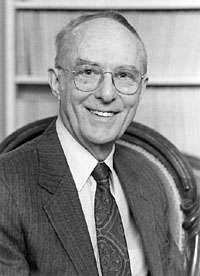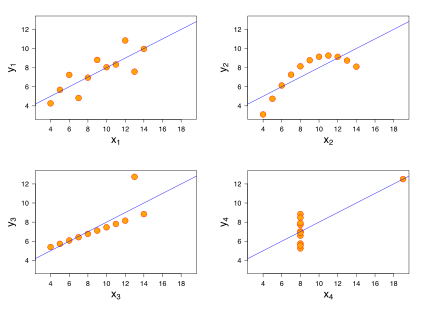Frank Anscombe
| Francis Anscombe | |
|---|---|
 | |
| Born |
13 May 1918 Hove, East Sussex |
| Died | 17 October 2001 (aged 83) |
| Residence |
United Kingdom United States |
| Citizenship | United Kingdom |
| Fields | Statistician |
| Institutions |
University of Cambridge Rothamsted Experimental Station Princeton University Yale University |
| Alma mater | Trinity College, Cambridge |
| Known for |
Analysis of residuals Anscombe's quartet Anscombe transform |
Francis John "Frank" Anscombe (13 May 1918 – 17 October 2001) was an English statistician.
Born in Hove in England, Anscombe was educated at Trinity College at Cambridge University. After serving in the Second World War, he joined Rothamsted Experimental Station for two years before returning to Cambridge as a lecturer.
In experiments, Anscombe emphasized randomization in both the design and analysis phases. In the design phase, Anscombe argued that the experimenters should randomize the labels of blocks.[1][2] In the analysis phase, Anscombe argued that the randomization plan should guide the analysis of data; Anscombe's approach has influenced John Nelder and R. A. Bailey in particular.
He moved to Princeton University in 1956, and in the same year he was elected as a Fellow of the American Statistical Association.[3] He became the founding chairman of the statistics department at Yale University in 1963.[4][5]

According to David Cox, his best-known work may be his 1961 account of formal properties of residuals in linear regression.[5][6] His earlier suggestion for a variance-stabilizing transformation for Poisson data is often known as the Anscombe transform.[7]
He later became interested in statistical computing, and stressed that "a computer should make both calculations and graphs", and illustrated the importance of graphing data with four data sets now known as Anscombe's quartet.[8] He later published a textbook on statistical computing in APL.[9]
In economics and decision theory he is best known for a 1963 paper with Robert Aumann which provides the standard basis for the theory of subjective probability.[10]
He was brother-in-law to another well-known statistician, John Tukey of Princeton University; their wives were sisters.[5]
References
- ↑ Anscombe, F. J. (1948). "The Validity of Comparative Experiments". Journal of the Royal Statistical Society. Series A (General). 111 (3): 181–211. doi:10.2307/2984159. JSTOR 2984159. MR 30181.
- ↑ Caliński, Tadeusz; Kageyama, Sanpei (2000). Block designs: A Randomization approach, Volume I: Analysis. Lecture Notes in Statistics. 150. New York: Springer-Verlag. ISBN 0-387-98578-6. MR 1781064.
- ↑ View/Search Fellows of the ASA, accessed 2016-07-23.
- ↑ Saxon, Wolfgang (25 October 2001). "Francis John Anscombe, 83, Mathematician and Professor". New York Times. Retrieved 2010-05-02.
- 1 2 3 Cox, D.R. (2003). "Frank Anscombe". Journal of the Royal Statistical Society, Series D. 52 (4): 679. doi:10.1046/j.0039-0526.2003.02064.x.
- ↑ Anscombe, F.J.; Tukey, J.W. (1963). "The Examination and Analysis of Residuals". Technometrics. Technometrics, Vol. 5, No. 2. 5 (2): 141–160. doi:10.2307/1266059. JSTOR 1266059.
- ↑ Anscombe, F.J. (1948). "The Transformation of Poisson, Binomial and Negative-Binomial Data". Biometrika. 35 (3–4): 246–254. doi:10.1093/biomet/35.3-4.246.
- ↑ Anscombe, F.J. (1973). "Graphs in Statistical Analysis". The American Statistician. The American Statistician, Vol. 27, No. 1. 27 (1): 17–21. doi:10.2307/2682899. JSTOR 2682899.
- ↑ Anscombe, F.J. (1981). Computing in Statistical Science through APL. New York: Springer-Verlag. ISBN 3-540-90549-9.
- ↑ "Anscombe, Aumann: A Definition of Subjective Probability".
- "Noted statistician Francis J. Anscombe dies". Yale Bulletin & Calendar. 30 (9). 2001-11-02.